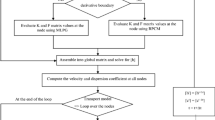Abstract
A new formulation for the modeling of density coupled flow and transport in porous media is presented. This formulation is based on the development of the mass balance equation by using the conservative form. The system of equations obtained by coupling the flow and transport equations using a state equation is solved by a combination of the mixed hybrid finite element method (MHFEM) and the discontinuous finite element method (DFEM). The former is applied in order to solve the flow equation and the dispersive part of the transport equation, whilst the latter is used to solve the advective part of the transport equation. Although the advantages of the MHFEM are known (efficiency calculation of velocity field and continuity of fluxes from one element to an adjacent one), its application in a classical development form (volumetric fluxes as unknowns) leads to the non-conservative version of the mass balance equation. The associated matrix of the system of equations obtained by hybridization is positive definite but non-symmetrical. By using a new approach (mass fluxes as unknowns) the conservative form of the continuity equation is preserved and the associated matrix of the system of equations obtained by hybridization becomes symmetrical. When applied to Elder's problem involving a strong density contrast, this new approach, with a lower calculation cost, leads to similar or identical results to those found in the specialized literature. The comparison between the conservative and non-conservative formulations solved with the same MHFEM and DFEM combination emphasizes the rigor and the pertinence of this new approach. Furthermore, we show the existence of a limit refinement defining the stability of the numerical solution for Elder's problem.
Similar content being viewed by others
References
Ackerer, Ph., Younès, A. and Mosé, R.: 1999, Modeling variable density flow and solute transport in porous medium: 1. Numerical model and verification, Transport in Porous Media 35, 345-373.
Bear, J.: 1979, Hydraulic of Groundwater, McGraw-Hill Series in Water Resources and Environmental Engineering, McGraw-Hill, New York.
Buès, M. A., and Oltean, C.: 2000, Numerical simulations for saltwater intrusion by the mixed hybrid finite element method and discontinuous finite element method, Transport in Porous Media, 40(2), 171-200.
Chavent, G. and Roberts, J. E.: 1991, A unified physical presentation of mixed, mixed hybrid finite elements and standard finite difference approximation for the determination of velocities in water flow problems, Adv. Water Resour. 14, 329-348.
Elder, J. W.: 1967, Transient convection in a porous medium, J. Fluid Mech. 27, 609-623.
Gowda, V. and Jaffré, J.: 1993, A discontinuous finite element method for scalar nonlinear conservation laws, Rapport de recherche INRIA 1848.
Henry, H. R.: 1964, Effects of dispersion on salt encroachment in coastal aquifers, U.S. Geol. Surv. Water Supply Paper, 1613-C, C71-C84.
Herbert, A.W., Jackson, C. P. and Lever, D. A.: 1988, Coupled groundwater flow and solute transport with fluid density strongly dependent upon concentration, Water Resour. Res. 24, 1781-1795.
Kolditz, O., Ratke, R., Diersch, H. J. and Zielke W.: 1997, Coupled groudwater flow and transport: 1. Verification of variable density flow and transport models, Adv. Water Res. 21(1), 27-46.
Leijnse, T.: 1989, Free convection for high concentration solute transport in porous medium, in: H. E. Kobus and W. Kinzelbach (eds), Contaminant transport in Groundwater, A.A. Balkema, Rotterdam, pp. 341-346.
Mosé, R., Siegel, P., Ackerer, Ph. and Chavent, G.: 1994, Application of the mixed hybrid element approximation in a groundwater flow model: luxury or necessity?, Water Resour. Res. 30, 3001-3012.
Oldenburg, M. C. and Pruess, K.: 1995, Dispersive transport dynamics in a strongly coupled groundwater-brine flow system, Water Resour. Res. 31, 289-302.
Oltean, C., Ackerer, Ph. and Buès, M. A.: 1994, Solute transport in 3D laboratory model through an homogeneous porous medium: behavior of dense aqueous phase and simulation, In: A. Peters, G. Wittum, B. Herrling, U. Meissner, C. A. Brebbia, W. G. Gray and G. F. Pinder (eds), Computational Methods in Water Resources X, Kluwer Academic Pub., Heidelberg, Germany, pp. 341-346.
Peyret, R. and Taylor, T. D.: 1983, Computational methods for fluid flow, Springer-Verlag, New York, pp. 358.
Raviart, P. A. and Thomas, J.M.: 1977, A mixed finite method for the second order elliptic problems, in Mathematical Aspects of the Finite Element Method, Lect. Notes Math. Springer-Verlag, New York, 292-315.
Roberts, J. E. and Thomas, J. M.: 1991, Mixed and hybrid methods, In: P. G. Ciarlet and J. L. Lions (eds), Handbook of Numerical Analysis, vol. 2, North-Holland, Amsterdam, pp. 523-639.
Siegel, P., Mosé, R., Ackerer, Ph. and Jaffré, J.: 1997, Solution of the advection-diffusion equation using a combination of discontinuous and mixed finite elements, Int. J. for Numer. Methods in Fluids 24, 595-613.
Thomas, J. M.: 1977, Sur l'analyse numérique des méthodes d'éléments finis hybrides et mixtes, PhD Thesis, Université Pierre et Marie Curie, Paris, France, pp. 311.
Voss, C. I.: 1984, SUTRA: A finite element simulation model for saturated-unsaturated, fluid density dependent groundwater flow with energy transport or chemically reactive single species solute transport, U.S. Geol. Surv. Water Resour. Invest. Rep., 84-4369, pp. 409.
Voss, C. I. and Souza, R. W.: 1987, Variable density flow and solute transport simulation of regional aquifers containing a narrow freshwater-saltwater transition zone, Water Resour. Res. 23, 1851-1866.
Weast, R. C.: 1977, CRC Handbook of Chemistry and Physics, 58th edn., Chemical Rubber Company Press, Boca Raton, Fla., D-252.
Author information
Authors and Affiliations
Rights and permissions
About this article
Cite this article
Oltean, C., Buès, M.A. Coupled Groundwater Flow and Transport in Porous Media. A Conservative or Non-conservative Form?. Transport in Porous Media 44, 219–246 (2001). https://doi.org/10.1023/A:1010778224076
Issue Date:
DOI: https://doi.org/10.1023/A:1010778224076




